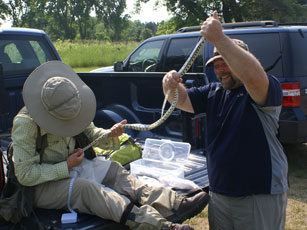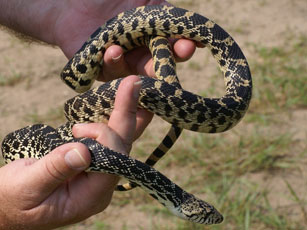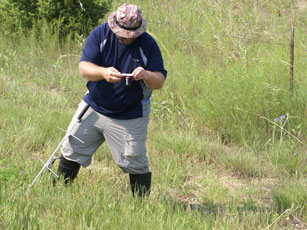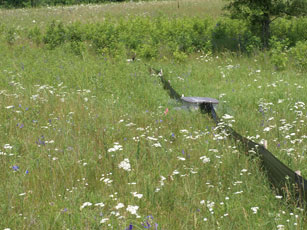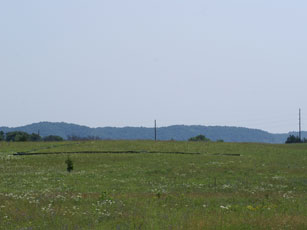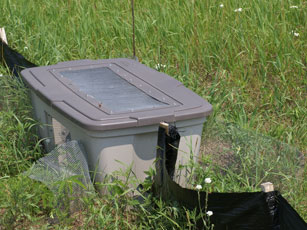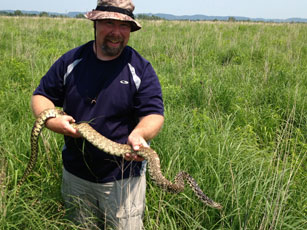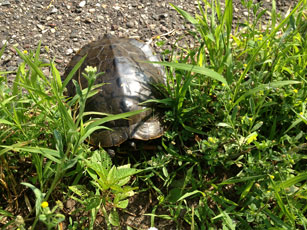
7-1-13
Trip Details
Location: Minnesota
Weather: Mostly clear skies. High in the mid-eighties, low humidity.
Time: 9:00 a.m. to 8:00 p.m.
Herpers: Jeff LeClere, Anne Yen, Bruce Brecke, Jim Scharosch
Account by: Jim Scharosch
Photos by: Jim Scharosch
Jeff LeClere came down to visit in early June and the conversation at one point turned to what he was doing at work. He told me about some survey and radio tracking work that was going on with bullsnakes and hognose snakes at two sites in Minnesota. Jeff works for the Minnesota DNR. I was thinking about how cool it would be for that to be a full time job, and I asked Jeff if it would be okay for me to come up and hang around with him for a couple of days on the job. He said it wouldn’t be a problem, so I kept it in the back of my mind for a couple of weeks, then hit him up for a visit the week of the Fourth of July holiday. It all worked out so I shot up there Sunday night and met up with Jeff on Monday morning.
I decided I wasn’t going to treat this like a “regular” herp trip. I wasn’t concerned with what animals I saw, in what quantities or what kind of photos I got of individual animals. This trip was about the experience of doing “real” herpetology and hanging out with Jeff. Any animals found would be a welcome bonus.
First thing we did was roll out to the field house where we would be staying for the next few days. Once there, we met up with Anne Yen who is a seasonal tech working for the DNR. After introductions, we moved our stuff into the field house and discussed what would be going on that day.
Jeff came out of the field house at one point, said something smart-alecky about paying attention and showed us the Bullsnake (Pituophis catenifer) he had just caught basking right next to the front porch of the field house. I looked over the other way and there was an adult eastern garter snake crawling away.
The bullsnake was a bit under four feet long, and a male if I remember correctly. Jeff and Anne proceeded to process the snake, taking length and weight measurements, and determining the sex. It was a new snake to the study so they implanted a PIT tag. If they recapture the snake, they can scan for the PIT tag and identify the snake as part of the study based upon a number embedded in the tag.
The snake didn’t want to sit still for photos so we released it back under the porch.That was a cool way to start the trip!
Soon after that, the three of us loaded into the truck and headed out to a sand prairie area nearby. There were two female bullsnakes in this area who were implanted with radio transmitters and we had to track them to see where they were currently located. The first snake we tracked was within fifty feet of where it had been located the day before, and was now within ten feet of the edge of the roadway, basking in some short grass. Even knowing where it was, and in this shorter grass, it was still difficult to pick it out.
We took a few photos, and recorded temperature, plant makeup and GPS coordinates. We didn’t disturb the snake. We tracked this snake the next two days and didn’t see her again. She moved about 75 feet back into the field from this roadside basking spot but buried into some thick grass tufts. Glad I got to see her the first day.
We took off to locate the second female and picked up a radio signal right away. She ended up being a few hundred yards away. This one was underground in a rodent burrow. We tracked this snake all three days to within a ten foot radius of the area we located her the first day. I never laid eyes on the snake during the trip, but it was still cool to see where she was hanging out. Wouldn’t surprise me if she was holed up in that burrow to lay her eggs.
Next we checked the first set of drift fences. We didn’t see anything in the funnel traps. The setups were very well put together. Here are a few pictures of the fences and traps.
From here we set off to try to locate one of the radio transmitter implanted male bullsnakes who had gone missing from the study. For most of the spring, this snake had hung out in the same field as these two females. About a week before I got there, it started moving and was last tracked to the far edge of the field. A week to the day from when I got there, it vanished from the radio receiver. Anne had taken a canoe into the nearby marsh and they had scanned fields in all directions trying to find this snake. We hopped into the truck and took off to check some distant fields. We were driving along the highway and passed over a dead snake on the road. We knew it wasn’t a bullsnake, but we pulled off to see what it was and collect some data. We were surprised to see it was a large milksnake, as it looked like a fox snake as we drove by.
While we were recording data on the milksnake, Anne took out the radio receiver and pointed it toward a field about a quarter mile away. We were all pretty surprised when it started beeping. We had located the missing bullsnake. We circled around the highway and drove down toward the field. We walked in fifty yards or so and as the radio receiver put us onto the snakes location, we heard it slide thru the tall grass and Jeff snagged it.
Later we determined that as the crow flies, it was about 1.4 miles from it’s last known location. It crossed thru a large forest, crossed a river and swam through marsh and cattail fields to reach this small five or so acre plot of marginal sand prairie. There was very little sign of rodent activity in this field and it was bordered by corn fields on the sides. We pondered what the snake might have known about the area, wondered if this was a return visit or a random journey. We will never know, but it was fun to discuss it. During this discussion, I decided this snake needed a name more appropriate than his transmitter frequency that was his current moniker so I dubbed him Marshie in honor of his swim across the marsh.
We released the snake quickly so as to disturb it as little as possible. After recording location data we went back to the field house and grabbed lunch. There I got to meet Bruce Brecke. He was a volunteer who was helping with the survey work. Bruce has been doing turtle work in the area since the 1970’s and was now pitching in to help with this snake study. He was with us the rest of the day.
After lunch we moved on to locate the other transmitter implanted male. This male had left it’s springtime haunt quite a bit earlier and had holed up in a small field near some cabins. It was residing under a decaying mound of sticks and brush. I never laid eyes on this snake either, and it never moved from its hiding location while I was there.
We did some driving around to try to arrange for a boat to use later that evening in an attempt to locate some calling cricket frogs. It ended up being too flooded to get to the boat, but we did see a few turtles crossing the road. This is one of the Map Turtles (Graptemys geographica) that we found on the road.
Next stop was to check the next set of drift fences. These had been put in place by a previous study and looked much older than the first set we checked. In the very last box of the very last fence, Jeff pulled out another bullsnake. This one was new to the study and ended up being fairly important, as it was to be another female that would be receiving a radio transmitter. I didn't take any pictures at the time because I knew I would have time later. The rest of her story comes tomorrow.


